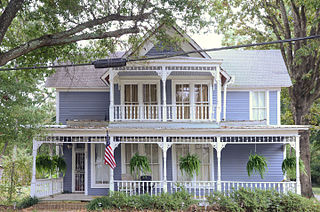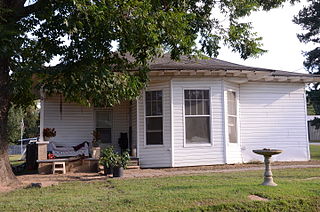
White County is a county located in the U.S. state of Arkansas. As of the 2010 census, the population was 77,076. The county seat is Searcy. White County is Arkansas's 31st county, formed on October 23, 1835, from portions of Independence, Jackson, and Pulaski counties and named for Hugh Lawson White, a Whig candidate for President of the United States. It is an alcohol prohibition or dry county, though a few private establishments can serve alcohol.

Highway 16 is an east–west state highway in Arkansas. The route begins in Siloam Springs at US Highway 412 (US 412) and Highway 59 and runs east through Fayetteville and the Ozark National Forest to US Highway 67 Business (US 67B) in Searcy. Highway 16 was created during the 1926 Arkansas state highway numbering, and today serves as a narrow, winding, 2-lane road except for overlaps of 10 miles (16 km) through Fayetteville. Much of the highway winds through the Ozarks, including the Ozark National Forest, where a portion of the highway is designated as an Arkansas Scenic Byway. The route has two spur routes in Northwest Arkansas; in Fayetteville and Siloam Springs.

Highway 110 is a designation for three east–west state highways in north central Arkansas. One segment of 16.71 miles (26.89 km) runs east from US Highway 65 (US 65) at Botkinburg to Highway 9/Highway 16 near Shirley. A second route of 3.15 miles (5.07 km) begins at Highway 16/Highway 92 in Greers Ferry and runs east to the lake shore of Greers Ferry Lake. A third segment of 20.43 miles (32.88 km) begins at the Sugar Maple Dr/Old Tr intersection outside Heber Springs and runs east to Highway 16 in Pangburn.
Doyle House may refer to:

The Col. Ralph Andrews House is a historic house at 517 W. Center St. in Beebe, Arkansas. Built c. 1885, it is one of a small number of houses in Beebe to survive from the early period of the city's growth. It is a 2+1⁄2-story wood-frame structure, with clapboard siding, and a Folk Victorian porch with turned posts and jigsawn brackets. The building's cruciform plan is fairly typical of houses built in White County during the period; this is one of the best-preserved of those that remain.

The James William Boggs House is a historic house on Austin Street in Pangburn, Arkansas. Located on the east side, between Torrence and South McKee Streets, it is a 1+1⁄2-story rambling wood-frame structure with a variety of gables, porches and projecting sections. Its front facade is dominated by a single-story hip-roofed porch supported by tapered square columns, and shelters a pair of entrances. To the rear of the main block a shotgun house was moved and attached. It was built in 1908 and is one of a small number of houses surviving from the period in White County.

The Cary House is a historic house at Searcy and Short Streets in Pangburn, Arkansas. It is a 1+1⁄2-story wood-frame structure with an irregular floor plan and vernacular styling. Its main facade, facing west, is dominated by a single-story shed-roof porch that wraps around to the side, and is supported by wooden box columns. Built about 1910, it is one of White County's few pre-World War I railroad-era houses to survive.

The Churchill-Hilger House is a historic house at Main and Searcy Street in Pangburn, Arkansas. It is a single-story wood-frame structure, basically vernacular in appearance with some Craftsman detailing. It has a hip roof from which hip-roof dormers project, and a recessed L-shaped porch that wraps around the northern (front) and western facades. The house was built in 1914 for Harry Churchill, one of the leading businessmen responsible for Pangburn's economic success in the early 20th century. Churchill arrived in Pangburn in 1899, and built up a lucrative business manufacturing railroad ties, and successfully lobbied for the construction of the railroad through the town. At the time of the house's construction, it was considered somewhat lavish.

The Rufus Gray House is a historic house at the southeast corner of Austin and South Streets in Pangburn, Arkansas, USA. It is a single-story wood-frame structure, with a hip-roofed central section that extends to projecting gables to the front and side. The front to the left of the gable section is sheltered by a shed-roof porch supported by Doric columns. The house was built about 1912 and is one of the few surviving houses in the community from this period.

The Livestock and Equipment Barn of the Glenn Homestead is a historic farm outbuilding in rural northern White County, Arkansas. It is located on the north side of Arkansas Highway 124, several miles east of the city of Pangburn. It is a two-story frame structure, clad in novelty siding and set on a concrete foundation. Its main section has a visually distinctive rounded roof, with open shed-roofed equipment wings on the sides. Built about 1939, it is the only known round-roofed barn in the county.

The Walter Marsh House is a historic house at Maple and Torrence Streets in Pangburn, Arkansas. It is a 1+1⁄2-story wood-frame structure, with a hip roof, novelty siding, and a stone foundation. The roof extends over a front porch, which is supported by simple box columns on piers. A two-window hip-roof dormer projects above the porch. Built about 1920, it is a well-preserved vernacular double-pile residence of the period.

The McAdams House is a historic house at Maple and South Streets in Pangburn, Arkansas. It is a single-story wood-frame structure, with a hip roof that has long and slightly flared eaves with exposed rafter tails. It is clad in novelty siding and rests on a foundation of stone piers. Built about 1915, it is one of the few well-preserved houses in White County from that time period.
The Dr. McAdams House was a historic house at Main and Searcy Streets in Pangburn, Arkansas. It was a 1+1⁄2-story vernacular wood-frame structure, with a hip-over-gable roof, novelty siding, and a foundation of stone piers. A porch extended across the front, supported by posts, with a projecting gable above its left side. Built about 1910, it was one of the best-preserved houses of the period in White County.
The Patman House was a historic house at Mountain and Jackson Streets in Pangburn, Arkansas. It was a 1+1⁄2-story T-shaped wood-frame structure, with a dormered gable roof, novelty siding, and a foundation of brick piers. It had modest vernacular Colonial Revival styling. It was built in the 1890s as a frame version of a dogtrot, but was significantly altered in the early 1920s, after Pangburn achieved prosperity as a railroad town.

The John Shutter House is a historic house at Austin and Main Streets in Pangburn, Arkansas. It is a 1+1⁄2-story wood-frame house, with a side-gable roof and a stone foundation. A hip-roofed porch extends across part of the front, supported by wooden columns mounted on stuccoed piers. A shed-roofed carport extends to the left side of the house. The house was built in 1908, and is one of a modest number of houses in White County surviving from that period.
The Smith-Moore House is a historic house at 901 North Main Street in Beebe, Arkansas. It is a 1+1⁄2-story wood-frame structure, with a side gable roof, weatherboard exterior, and a foundation of brick piers. Its front facade has three gabled wall dormers above its entry porch, and there is a carport extending to the right. The house was built about 1880, and is one of the few houses in White County surviving from that period.
The Albert Whisinant House is a historic house off Arkansas Highway 16 in rural northern White County, Arkansas. It is located southeast of Pangburn, on a drive that originally extended from Green Valley Lane in the north to AR 16 in the south, but is now only accessed from the north. It is a single story vernacular wood-frame structure, with a gabled roof, novelty siding, and a foundation of stone piers. In a survey of the county's historic buildings, it was the only one of its period that had separate entrances into three separate rooms.

The Avanell Wright House is a historic house at Main and Pine Streets in Pangburn, Arkansas. It is a single story L-shaped wood-frame structure, with a stone foundation, novelty siding, and a cross-gable roof that has a central pyramidal section. The roof line of the central section extends downward over a porch located in the crook of the L, with Tuscan columns for support. The house was built about 1910, and is one of relatively few surviving houses from that period in the community.

Roberts Clinic, a historic Colonial Revival building completed in 1937, was the first medical facility in Austin, Texas established to provide hospital rooms and care exclusively for the comfort of American Black patients. The practice offered treatment for acute and chronic illnesses, preventive treatment, minor surgeries, labor, delivery, and abortion services through the 1960s.
















